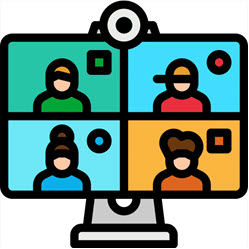
No one can deny that the COVID-19 pandemic has accelerated the use of video conferencing.
The use of platforms such as Zoom, GoTo Meeting, and Google Meet have all grown more than anyone could have anticipated. Love them or hate them, virtual meetings have become part of the daily lives of many who work remotely.
On the surface, virtual meetings appear to be saving on many things—from transportation expenses to time and convenience. Yet, lurking behind the scenes is a little-known fact: video conferencing produces negative environmental impacts.
Adds carbon dioxide emissions

According to a study conducted by researchers from Purdue University, Yale University, and the Massachusetts Institute of Technology, one hour of videoconferencing or streaming emits 150 to 1,000 grams of carbon dioxide.
To put this in perspective. A gallon of gasoline burned from a car emits about 8,887 grams.
Get eight people on a virtual meeting for an hour, and you’ve just burned the equivalent of an entire gallon of gasoline. 100 people on a webinar? Do the math!
Depletes resources: water and land

Adding carbon dioxide to the atmosphere is not the only environmental factor at play. That same one-hour video conference or streaming event also uses 2 to 12 liters of water.
What’s more, it requires a land area about the size of an iPad Mini. Add up all those meetings. Their water and land impacts add up too.
The global picture
On an even larger scale is the global picture. If Internet usage trends continue through the end of 2021 at their current rate, it will take about 71,600 square miles—two times the size of Indiana—to absorb the carbon dioxide produced and restore our clean air.
There’s more:
- The additional water needed for processing and transmission of all this data will fill up more than 300,000 Olympic-size swimming pools.
- The resulting land footprint will just about equal the size of Los Angeles.
While videoconferencing usually lowers the impact when compared to participants driving to work or flying to meet clients, it still produces a footprint.
The impact of turning off your camera

There is a very easy way you can help save the planet when you meet virtually.
Simply by turning off your camera, you can reduce the environmental impact of video conferencing by up to 96%. This is significant! And so easy to do.
For those who would rather not display such a detailed close-up, there is now a great reason to avoid doing so. Just bookmark this post. Show it to your boss, co-workers, and family.
To keep things interactive, you could choose to have everyone start the meeting with their camera on. Then turn it off and only show it when needed. You could also come up with other ideas about how to use your camera less often.
Here’s hoping you remember to take this one positive step and reduce your environmental footprint every time you begin a virtual meeting.
Source: The overlooked environmental footprint of increasing Internet use
About the Author

Bev founded Top Of The List in 2006 and has over 25 years of experience working with technology. In her free time, she competes in dog agility competitions with her Golden Retrievers, Cosmo, and Finn.




